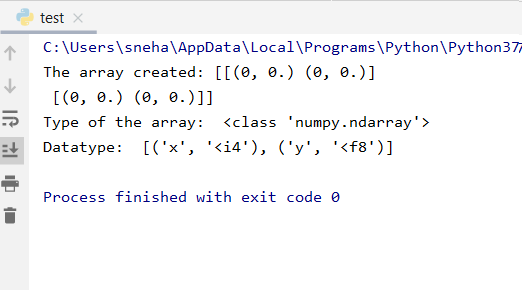np zeros Python | What does 0 mean in Python

np zerosPython, provided by the NumPy library, is used to create NumPy arrays filled with zeros. Its primary purpose is array initialization, often used in data analysis, scientific computing, and machine learning. By specifying the shape and data type, you can customize the array.
For example, np.zeros((2, 3), dtype=int) generates a 2×3 integer array. It plays a crucial role in preallocating memory for numerical operations, enhancing efficiency. Common uses include preparing data structures, initializing neural network weights, and creating templates for image processing. It’s essential for tasks where you need arrays with specific dimensions and initial values, providing a foundation for numerical computation.
What is np zeros Python and what uses?

In Python, “np.zeros” typically refers to the “zeros” function provided by the NumPy library. NumPy is a widely used library for numerical and scientific computing in Python. The “np” is a common alias used for NumPy, making it more concise to work with.
The np.zeros function in NumPy is used to create an array filled with zeros. Its primary purpose is to initialize arrays with zeros of a specified shape and data type. Here’s the basic syntax for np.zeros:
np.zeros(shape, dtype=float, order=’C’)
shape: This parameter specifies the dimensions (shape) of the array you want to create and should be given as a tuple of integers. For example, to create a 2D array with 3 rows and 4 columns, you would useshape=(3, 4).dtype(optional): This parameter allows you to specify the data type of the elements in the array. The default isfloat, but you can choose other data types, such asint,bool, or more complex data types likecomplex.order(optional): This parameter specifies the memory layout of the array and can be set to ‘C’ (C-style, row-major) or ‘F’ (Fortran-style, column-major). The default is ‘C’.
Here’s an example of how to use np.zeros to create a 2D array filled with zeros:
import numpy as np
# Create a 3×4 array filled with zeros
zeros_array = np.zeros((3, 4))print(zeros_array)
This code will produce the following NumPy array:
array([[0., 0., 0., 0.],
[0., 0., 0., 0.],
[0., 0., 0., 0.]])
Thenp.zeros function is useful when you need to initialize arrays before performing numerical computations or when you want to create arrays for various applications, such as data analysis, machine learning, and scientific simulations. You can then manipulate and work with the data in the array using NumPy’s extensive set of functions and operations.
What is the numpy.zeros() function in Python?
The numpy.zeros() function in Python is a part of the NumPy library, which is widely used for numerical and scientific computing. This function is used to create a new NumPy array filled with zeros. It allows you to specify the dimensions (shape) of the array you want to create.
You can use numpy.zeros() to initialize arrays with zeros, and then you can manipulate the data in the array using NumPy’s various functions and operations.
Overview
The numpy.zeros():To return a new array of a specified shape and type that is entirely composed of zeros, use the numpy.zeros() function.
Syntax
The function has the following syntax:
numpy.zeros(shape, dtype=float, order='C', *, like=None)
Parameters
The numpy.zeros() function takes the following parameter values:
shape: This stands for the new or desired array.dtype: This is optional and serves to represent the intended array data type.like: This is the prototype or the array_like object.
What does np zeros_like do in Python:

In Python’s NumPy library, the np.zeros_like function is used to create a new NumPy array that has the same shape and data type as an existing array. It effectively replicates the shape and data type of the input array but fills the new array with zeros.
Here’s the basic syntax for np.zeros_like:
np.zeros_like(a, dtype=None, order=’K’, subok=True)
a: This parameter is the input array for which you want to create a new array with the same shape and data type.dtype(optional): This parameter allows you to specify the data type for the new array. If not provided, the data type will be the same as the input arraya.order(optional): This parameter specifies the memory layout of the new array. It can be set to ‘K’ (keep input order, default), ‘C’ (C-style, row-major), or ‘F’ (Fortran-style, column-major).subok(optional): If set toTrue(default), the function returns a subclass ofnp.ndarray. If set toFalse, it returns an array of the base classnp.ndarray.
Here’s an example of how to use np.zeros_like:
import numpy as np
# Create an example array
original_array = np.array([[1, 2, 3], [4, 5, 6]])# Create a new array with the same shape and filled with zeros
zeros_array = np.zeros_like(original_array)print(zeros_array)
In this example, np.zeros_like create a new NumPy array with the same shape as original_array (a 2×3 array) and fill it with zeros. The result will look like this:
array([[0, 0, 0],
[0, 0, 0]])array([[0, 0, 0],
[0, 0, 0]])
This can be useful when you want to initialize a new array that has the same shape and data type as an existing array, which is often encountered in data processing and numerical computations.

What does 0 mean in Python:
In Python, the number 0 is a literal representing the integer zero. It is a fundamental numerical value and has several important uses and meanings in the Python programming language:
1.. Zero as an Integer: 0 represents the integer zero. It’s a whole number that is neither positive nor negative. For example, you can use 0 it in mathematical calculations or to represent the absence of a quantity.
2. Comparisons: In Python, you can use 0 comparison operations. For example, you can use it to check if a variable is equal to zero:
x = 0
if x == 0:
print(“x is equal to zero”)
3. Loop Control: You can use 0 loop control statements. For example, you can use it as an initial value in a for or while loop to set a counter to zero.
for i in range(0, 5):
print(i) # This will print numbers from 0 to 4
4. List Indexing: In Python, lists are zero-indexed, meaning the first element in a list has an index of 0. For example:
my_list = [10, 20, 30]
first_element = my_list[0] # This retrieves the first element (10)
5. String Slicing: When working with strings, you can use zero-based indexing to access characters in the string. The first character is at the index 0.
text = “Python”
first_character = text[0] # This retrieves the first character ‘P’
6. Boolean Context: In boolean expressions, 0 is considered as False, and any non-zero integer is considered as True.
x = 0
if x:
print(“This will not be printed because x is considered False in a boolean context.”)
7. Default Values: In function and method definitions, you can use 0 as a default value for function parameters.
def multiply(a, b=0):
return a * bresult = multiply(5) # If b is not provided, it defaults to 0.
These are some of the common uses of the integer 0 in Python. It’s a fundamental concept in programming, especially when dealing with numeric data and control structures.
See Also:
- Unveiling the Distinctions: Web Crawler vs Web Scrapers
- How to Make Money with Web Scraping Using Python
- How to Type Cast in Python with the Best 5 Examples
- Best Variable Arguments in Python
- 5 Best AI Prompt Engineering Certifications Free
- 5 Beginner Tips for Solving Python Coding Challenges
- Exploring Python Web Development Example Code
- “Python Coding Challenges: Exercises for Success”
- ChatGPT Prompt Engineering for Developers:
- How to Make AI-Generated Video|AI video generator
- 12 Best Python Web Scraping Tools and Libraries with Pros & Cons
- 7 Best Python Web Scraping Library To Master Data Extraction
- Explore the World of Character AI Generator
- Boolean Operators in Python Examples (And|Or|Not)
- Python List Slicing: 3 Best Advanced Techniques





